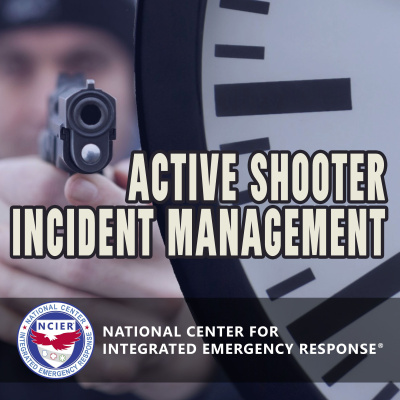Sinopsis
This C3 Pathways Podcast series discusses Active Shooter Incident Management (ASIM). The Podcast features instructors and special guests discussing key elements and challenges of Active Shooter Incident Management and the implications for law enforcement, fire, and EMS responders. The bad guy and the clock both kill innocent victims. Don't miss the opportunity to gain key insights that may help you save lives!
Episodios
-
Ep 118: You Use This Everyday
18/08/2025 Duración: 23minToday’s episode tackles the question How can first responders get real practice with active shooter incident management—when true incidents are (thankfully) rare in a career? Our panel explores practical strategies for integrating incident management skills into everyday calls and routine events—so you're always prepared, even if you only see a "big one" once in your career.Key highlights:Discover how to build skills by applying active shooter incident management techniques during regular calls (like missing persons, single-patient shootings, or barricaded suspect events).Learn why adopting consistent terminology and roles on low-risk or special event calls (like fairs or football games) builds strong incident command habits.Hear examples of leveraging staging, tactical roles, and unified command in day-to-day operations—on both fire/EMS and law enforcement sides.Find out how these daily practices help responders break down silos, develop relationships, identify training gaps, and get more comfortable with cr
-
Ep 117: Managing Uninjured Survivors
04/08/2025 Duración: 27minWhat happens to the uninjured survivors after an active shooter or mass casualty event? In Episode 117 of the Active Shooter Incident Management podcast, host Bill Godfrey and his team of instructors from the National Center for Integrated Emergency Response dive into the complex challenges faced by responders when managing large crowds of uninjured survivors at outdoor and indoor venues.This discussion covers:Immediate actions law enforcement and EMS must take with panicked, fleeing crowdsTactics for identifying witnesses, potential victims, and bystanders—and why separating these groups is crucialThe importance of security, safe holding areas, and the real-life logistics of "corralling" hundreds of peopleHow to use bystanders and uninjured family members to assist with patient care when resources are scarceDifferences in managing survivors at outdoor parks versus indoor sites like courthouses or schoolsWhy survivors must be shielded not just from physical threats, but also from re-traumatization and the med
-
Ep 116: Incident Management vs. Tactics
21/07/2025 Duración: 24minEmergency response agencies tend to spend much more time on tactics training—like room clearing or forming rescue teams—than on incident management, which focuses on organizing resources and ensuring everyone works together effectively. The podcast argues that both are equally important and should be integrated, suggesting agencies use small, realistic joint drills with law enforcement, fire, and EMS to build communication skills, clarify roles, and improve overall incident outcomes, rather than keeping these trainings separate or overly complicated.We dive deep into:The differences and importance of tactics vs. incident management training for law enforcement, fire, and EMS.Why agencies often train in silos and how this can leave critical communication and coordination gaps.The need for cross-training—why everyone, from street patrol to senior leadership, should understand both tactical skills and incident management.Practical ways to integrate incident management into everyday tactical drills, including mic
-
Ep 115: Outside Threats
07/07/2025 Duración: 25minEpisode 115 of the Active Shooter Incident Management Podcast focuses on how first responders deal with active shooter threats that happen outdoors, like at concerts, fairs, parks, or theme parks. The host, Bill Godfrey, talks with experts from law enforcement and fire/EMS about what makes these outdoor incidents different and more challenging than those inside buildings.Main Points:Outdoor active shooter events are harder to manage because there is less cover and the area is much bigger. Responders have to think about where crowds gather, how big the crowd might be, and where an attacker could strike. Planning ahead is very important, including working with venue staff and making sure everyone knows the emergency plan.The team discusses the difficulties of providing cover in outdoor environments that face threats like vehicle ramming or IEDs, highlighting the importance of area denial, physical barriers (such as movable trucks or fire trucks), and deploying quick reaction forces.For fire and EMS, it’s import
-
Ep 114: What is an Active Threat?
23/06/2025 Duración: 25minIn this episode, our hosts dive into what truly defines an "active threat," focusing on scenarios like active shooter events and the critical decisions first responders must make in real time. They discuss how to recognize when a threat is still actively causing harm versus when the situation shifts and responders need to quickly transition from pursuing the attacker to providing lifesaving care to victims.The conversation highlights the importance of situational awareness, explaining that if responders continue searching for a threat after the danger has passed, it can delay medical help and cost lives. The episode also covers the challenges law enforcement faces in recognizing these transition points, the impact of training and communication, and why understanding the difference between an active threat and a cleared scene is crucial for saving lives during high-stress incidentsKey Points CoveredDefining “Active” in Active ThreatsThe episode explores what it truly means for a threat to be “active,” emphasiz
-
Ep 113: What Is Your Mission?
09/06/2025 Duración: 22minIn today’s episode our panel dives into the essential mission for all responders—law enforcement, fire, and EMS—when confronting an active shooter event. The discussion centers on understanding and executing the three core priorities that define a successful response:1. Deal with the Active ThreatThe immediate mission for law enforcement is to neutralize the threat—stop the shooter and end the active killing. This requires rapid assessment of where the threat is, what’s driving it, and decisive action to intervene.2. Rescue the InjuredOnce the active threat is under control, the focus must shift quickly to rescuing and treating the wounded. Stopping the killing and stopping the dying are inseparable: you need to save every life possible by getting medical care to victims as soon as possible. This phase requires strong integration and communication between law enforcement and fire/EMS, often through rescue task forces entering warm zones.3. Clear and Secure the SceneThe third priority is to clear the facility
-
Ep 112: RTF Deployment Teamwork
23/05/2025 Duración: 32minToday’s episode takes a close look at how police, fire, and EMS come together to form Rescue Task Forces (RTFs) and why true interagency teamwork is essential for saving lives during high-risk incidents. The episode emphasizes that successful RTF deployment depends on much more than just assembling personnel; it requires careful pre-deployment briefings, clear communication about roles and expectations, and a unified approach to movement and safety as the team enters potentially dangerous environments.Before deploying, RTF members -comprised of both law enforcement officers and fire/EMS personnel – must understand who is responsible for medical decisions and who controls team movement. Law enforcement provides security and directs the team's movement, while medical personnel focus on triage and patient care; both elements must trust each other and communicate constantly to adapt to changing threats and patient needs.The episode also highlights the importance of sequencing and structure. RTFs are not sent in u
-
Ep 111: Three Scenes
31/03/2025 Duración: 25minEvery active shooter incident involves a minimum of three crime scenes: the location of the shooting, the suspect's mode of transportation, and their residence. But these scenes are just the beginning—additional challenges like jurisdictional coordination, evidence preservation, and responder safety add layers of complexity to these high-stakes situations.Topics covered include:Identifying and managing multiple crime scenes.The role of area command in resource allocation.The importance of digital forensics and intelligence gathering.Challenges posed by mobile attackers and spree events.Effective delegation and communication strategies during incidents.The critical role of hospitals and reunification centers in response efforts.Whether you're a first responder, incident commander, or simply interested in emergency management, this episode provides valuable insights into handling these dynamic and resource-intensive events.View this episode on YouTube at: https://youtu.be/6yfIizr-oJs
-
Ep 110: Tactical or Management
24/03/2025 Duración: 28minToday’s panel tackles a critical question: What’s the difference between tactics and management in active shooter events?The team dives into the distinct roles of tactical execution and incident management, exploring how these elements must work together to ensure a successful response. From law enforcement's focus on neutralizing threats to fire/EMS responsibilities in triage and rescue, the discussion highlights common gaps in training and coordination. They also share insights on the importance of knowing your role, effective communication, and integrating cross-discipline teamwork.Key topics include:The balance between tactical actions and resource management.Challenges faced by tactical group supervisors and triage leaders.The importance of training that incorporates both tactical execution and incident management.Strategies for improving coordination between law enforcement, fire, and EMS teams.View this episode on YouTube at: https://youtu.be/rshUHEADH64
-
Ep 109: Don't Let a Locked Door Cost Lives
17/03/2025 Duración: 23minIn today’s episode, our panel discusses the importance of effective door breaching techniques during emergency situations, such as active shooter incidents. The conversation emphasizes the need for law enforcement to be proficient in using the right tools and methods to quickly gain access to locked areas. Key topics include understanding door types, leveraging alternate entry points like windows, and the importance of training with fire departments. By highlighting these essential skills, the episode underscores the urgency of breaching in life-threatening situations where every second counts.View this episode on YouTube at: https://youtu.be/I1_RzHt5lHY
-
Ep 108: Response to Hospital Shootings Revisited
10/03/2025 Duración: 35minEpisode 108 revisits the critical topic of responding to shootings in healthcare facilities. Instructors from the National Center for Integrated Emergency Response (NCIER) delve into the unique challenges faced by healthcare facilities during active shooter events.This thought-provoking episode offers guidance on balancing healthcare providers' duty of care with personal safety during violent incidents. Listeners will gain a deeper understanding of the differences between targeted shootings and active shooter events, learning how responses should adapt to each scenario. The discussion explores strategies for seamless integration of hospital incident command systems with public safety command posts, emphasizing the importance of collaboration between healthcare facilities and law enforcement.Practical preparedness tips are a key focus, with actionable recommendations for training staff in high-risk areas such as ICUs and operating rooms to make rapid, informed decisions. The panel also shares valuable insights
-
Ep 107: Response to Hospital Shootings
03/03/2025 Duración: 37minToday’s episode delves into the complex challenges faced when responding to hospital-based shooting incidents and the strategies needed to address them effectively. Hospitals must grapple with the challenge of maintaining open access for critical care while ensuring security. Our panel explores several key issues including: Statistical insights on hospital shootings and their common locations (e.g., ERs, parking lots, patient rooms).The role of armed security and its impact on deterrence and response.Complexities of hospital lockdowns, including partial vs. full lockdowns and logistical hurdles like patient care continuity.The integration of Rescue Task Forces (RTFs) with hospital staff and the need for trauma-specific training. A significant focus of the episode is the importance of coordination between hospital administrators and public safety agencies. The discussion emphasizes the need for joint training and planning to address potential conflicts between hospital incident command systems and public safet
-
Ep 106: Voluntary Forced Training
17/02/2025 Duración: 31minIn Episode 106 of the Active Shooter Incident Management podcast, host Bill Godfrey and instructors Scott Formankiewicz, Kami Maertz, and Terrance Weems explore the concept of "voluntary forced training" for implementing active shooter incident management processes. The episode offers valuable insights for public safety professionals looking to improve inter-agency cooperation and implement new incident management strategies.The discussion covers several key areas, including building relationships across agencies to foster cooperation, starting small to demonstrate success and gain buy-in, and overcoming resistance to change in law enforcement culture. The instructors emphasize the power of joint training to break down barriers between agencies and highlight the importance of focusing on terminology and role-specific tasks as a starting point.Throughout the episode, the panel addresses challenges in getting leadership buy-in and offers strategies to overcome them. They stress the significance of investing in
-
Ep 105: Executing Many Tasks
10/02/2025 Duración: 32minIn Episode 105, our panelists explore how the order of actions can significantly impact the effectiveness of emergency response to active shooter events. Doing things in the right order simultaneously can ultimately save lives. Key topics covered in this episode include:The crucial role of proper task prioritization in crisis managementHow law enforcement and medical teams coordinate their effortsThe challenges of balancing threat neutralization with casualty careThe importance of quickly establishing staging areas and managing resourcesHow integrated training improves coordination between different response teamsWe also discuss the use of checklists to ensure proper sequencing and manage the complexity of the response. This episode offers valuable insights into the intricate world of active shooter response, highlighting how strategic planning and coordination can make a substantial difference in high-stakes situations. Join us to gain a deeper understanding of the complexities involved in active shooter res
-
Ep 104: Ballistic Protection for EMS
03/02/2025 Duración: 24minEpisode 104 features a panel discussion with law enforcement and Fire EMS, delving into the benefits, challenges, and practical considerations of implementing body armor for emergency medical services. While the risk of EMS personnel getting shot in active shooter events is relatively low, body armor can provide an additional layer of safety. However, implementing ballistic protection is not a simple task and requires careful consideration of various factors including fit and comfort, cost and maintenance, mobility and size variations.View this episode on YouTube at https://youtu.be/I785vhYyHR8
-
Ep 103: Virtual Training
27/01/2025 Duración: 35minEpisode 103 delves into the world of virtual training for active shooter incident management, showcasing its effectiveness and benefits. The discussion highlights how this innovative approach combines functional-level computer simulations with full-scale management exercises, allowing for realistic scenarios without the logistical challenges of traditional training methods.The episode explores the training structure, learning process, skills developed and the advantages over traditional “live” exercises. This virtual approach to training provides a balance between realism and practicality with the added advantage of being able to conduct multiple scenarios in a short time frame. Virtual training provides a balanced approach to preparing law enforcement and emergency responders to active shooter incidents in a controlled, yet realistic environment.View this episode on YouTube at https://youtu.be/vmN0MPcMYEM
-
Ep 102: You're First. Now What?
20/01/2025 Duración: 26minIn today’s episode our panel discusses the duties and responsibilities of the first arriving officers to an active shooter event. Our panel provides critical insights into the management of active shooter situations and the crucial moments when first responders arrive and make initial entry. From the initial approach, to providing comprehensive size-up reports, to managing resources effectively, this episode offers essential knowledge for law enforcement, fire and EMS personnel to effectively manage these chaotic situations.View this episode on YouTube at https://youtu.be/CHu1LEtbBvg
-
Ep 101: Overcoming Resistance To Change
13/01/2025 Duración: 49minIn today’s episode our panelists discuss the challenges of implementing change in emergency response protocols. The episode delves into common obstacles faced by change agents within organizations and offers insights on overcoming resistance. Key topics covered include: *Communication barriers between agencies during crisis events *The importance of building relationships and training together before incidents occur *Challenges with radio interoperability and potential solutions *The pitfalls of siloed operations and the need for true unified command *Overcoming cultural differences between law enforcement and fire/EMS *The power of "inverted thinking" in emergency planning *Strategies for motivating change at various organizational levelsThe hosts share personal experiences and practical advice for those seeking to improve active shooter response procedures. They emphasize the critical nature of inter-agency cooperation and effective communication in cr
-
Ep 100: Mastering Reunification Part 2
06/01/2025 Duración: 33minIn today’s podcast we continue the discussion with John-Michael Keyes, Stacy Avila, and Kevin Burd from the I Love U Guys Foundation about the Standard Reunification Method (SRM) and its complementary nature to the School Safety and Violent Event Incident Management (SSAVEIM) courses. Reunification is a complex process that requires thorough planning and practice along with crucial communication between schools and public safety agencies. The episode highlights two main training programs: 1. REx (Reunification Exercise): A two-day program that includes: - Day 1: Covering Standard Response Protocol and Standard Reunification Method - Day 2: Practical exercises with participants role-playing as students, parents, and reunification team members 2. SSAVEIM (School Safety and Violent Event Incident Management): Focuses on: - Active shooter response for public safety personnel - Helping educators understand the public safety response
-
Ep 99: Mastering Reunification Part 1
30/12/2024 Duración: 29minIn today’s podcast we discuss the importance of reunification training and exercises for schools and public safety organizations. John-Michael Keyes, Stacy Avila, and Kevin Burd from the I Love U Guys Foundation speak with Bill Godfrey, focusing on their respective approaches to reunification training. The podcast highlights the complementary nature of different training approaches and emphasizes the importance of collaboration between schools and public safety organizations in preparing for and executing reunification procedures.Key Points:Training ProgramsThe Standard Reunification Method (SRM) by the I Love You Guys FoundationSchool Safety and Violent Event Incident Management (SSAVEIM) by the National Center for Integrated Emergency ResponseReunification Exercise (REx) classImportant AspectsSimulation of realistic scenarios without recreating the triggering eventCollaboration between school staff and public safety personnelBenefits of TrainingReduces stress and anxiety about reunificationProvides insight

































